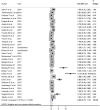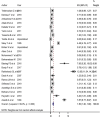Sero-epidemiology and associated factors of HIV, HBV, HCV and syphilis among blood donors in Ethiopia: a systematic review and meta-analysis
- PMID: 34372772
- PMCID: PMC8351159
- DOI: 10.1186/s12879-021-06505-w
Sero-epidemiology and associated factors of HIV, HBV, HCV and syphilis among blood donors in Ethiopia: a systematic review and meta-analysis
Abstract
Background: Transfusion transmissible infections (TTIs) remain a major public health problem in developing countries including Ethiopia. In Ethiopia, comprehensive information about sero-epidemiology of major TTIs is lacking at the national level. Therefore, this systematic review and meta-analysis was aimed at providing the pooled estimate of human immunodeficiency virus (HIV), hepatitis B virus (HBV), hepatitis C virus (HCV) and syphilis among blood donors in Ethiopia.
Methods: Relevant studies published until May 31, 2019 were searched through PubMed/Medline, EMBASE, SCOPUS, HINARI, Cochrane database library, Web of Science, Google Scholar and Google. The methodological quality of articles was assessed using Joanna Brigg's Institute critical appraisal checklist for prevalence and analytical studies. The pooled sero-epidemiology of HIV, HBV, HCV and syphilis were determined using the random-effects model. Heterogeneity between the studies was assessed using the I2 statistics. Publication bias was assessed by visual inspection of the funnel plot and Egger's statistics.
Results: A total of 7921 articles were retrieved, and 7798 were screened for eligibility after duplicates removed. Forty-nine full-text articles were assessed for eligibility; of which 45 were eligible for qualitative and quantitative synthesis: categorized as 36, 34, 31 and 23 studies for estimations of HBV, HIV, HCV and syphilis, respectively. In the random-effects model, the pooled sero-epidemiology of HBV, HIV, HCV and syphilis was 5.20, 2.83, 0.93 and 1.50%, respectively. Moreover, being a male blood donor was significantly associated with HBV and syphilis infection, whereas being a replacement blood donor was significantly associated with a high burden of HIV, HBV and HCV infections.
Conclusion: The pooled sero-epidemiology of major TTIs among blood donors was high. Therefore, there is a need to design prevention and control strategies in a comprehensive approach to reduce the burden.
Keywords: Blood donors; Ethiopia; Meta-analysis; Sero-epidemiology; Systematic review; Transfusion-transmissible Infections.
© 2021. The Author(s).
Conflict of interest statement
The authors declared that there is no competing interests.
Figures










Similar articles
-
Prevalence and factors associated with transfusion-transmissible infections (HIV, HBV, HCV and Syphilis) among blood donors in Gabon: Systematic review and meta-analysis.PLoS One. 2024 Aug 19;19(8):e0307101. doi: 10.1371/journal.pone.0307101. eCollection 2024. PLoS One. 2024. PMID: 39159193 Free PMC article.
-
Seroprevalence and diagnosis of HIV, HBV, HCV and syphilis infections among blood donors.Hum Antibodies. 2017;25(1-2):39-55. doi: 10.3233/HAB-160304. Hum Antibodies. 2017. PMID: 28009328
-
Sero-epidemiology of human immunodeficiency virus, hepatitis B and C viruses, and syphilis infections among first-time blood donors in Edéa, Cameroon.Int J Infect Dis. 2013 Oct;17(10):e832-7. doi: 10.1016/j.ijid.2012.12.007. Epub 2013 Jan 11. Int J Infect Dis. 2013. PMID: 23317526
-
Sero-prevalence of transfusion transmittable infections: HIV, Hepatitis B, C and Treponema pallidum and associated factors among blood donors in Ethiopia: A retrospective study.PLoS One. 2020 Oct 29;15(10):e0241086. doi: 10.1371/journal.pone.0241086. eCollection 2020. PLoS One. 2020. PMID: 33119668 Free PMC article.
-
Seroprevalence of hepatitis c virus infection among blood donors in Ethiopia: a systematic review and meta-analysis.BMC Infect Dis. 2021 Jan 30;21(1):131. doi: 10.1186/s12879-021-05827-z. BMC Infect Dis. 2021. PMID: 33516181 Free PMC article.
Cited by
-
Sero-prevalence and associated factors of sexually transmitted infections among youth-friendly services Attendees.PLoS One. 2023 Jan 23;18(1):e0279900. doi: 10.1371/journal.pone.0279900. eCollection 2023. PLoS One. 2023. PMID: 36689437 Free PMC article.
-
Prevalence and incidence of transfusion-transmissible infections among blood donors in Malawi: A population-level study.Transfus Med. 2023 Dec;33(6):483-496. doi: 10.1111/tme.13006. Epub 2023 Oct 12. Transfus Med. 2023. PMID: 37828838 Free PMC article.
-
Syphilis seroprevalence and risk factors among first-time blood donors in Brazil: A comprehensive repeated cross-sectional analysis spanning a decade.PLoS One. 2025 Feb 21;20(2):e0315933. doi: 10.1371/journal.pone.0315933. eCollection 2025. PLoS One. 2025. PMID: 39982941 Free PMC article.
-
Seroprevalence of human immunodeficiency virus in African blood donors: a systematic review and meta-analysis.EBioMedicine. 2024 Jul;105:105210. doi: 10.1016/j.ebiom.2024.105210. Epub 2024 Jun 28. EBioMedicine. 2024. PMID: 38941957 Free PMC article.
-
Prevalence of HIV, HBV, and HCV infections and high-risk behaviors among women referred to drop-in centers in Lorestan Province, western Iran.Arch Razi Inst. 2024 Jun 30;79(3):623-628. doi: 10.32592/ARI.2024.79.3.623. eCollection 2024 Jun. Arch Razi Inst. 2024. PMID: 39736956 Free PMC article.
References
-
- Musavi H, Rahimi H, Kooti W, Dorostkar R, Azami M, Sharghi M, Ashrafi-Zadeh H, Firoozbakht M, Taheri RA. Prevalence of human immunodeficiency virus in Iranian blood donors: a systematic review and meta-analysis. Arch Iran Med. 2018;21(6):260–267. - PubMed
-
- Patel PA, Patel SP, Oza HV. Seroprevalence of transfusion transmitted infections (TTIs) in blood donors at western Ahmedabad-A secondary care hospital based study. Int J Biol Med Res. 2012;3(2):1806–1810.
-
- Azerefegn E, Worku M, Hailemariam M. Transfusion-transmissible infections among blood donors at Hawassa Regional Blood Bank Center, South Ethiopia. IJRSMB. 2018;4(3):10–16.
-
- WHO: Global Status Report on Blood Safety and Availability 2016, 2017. File:, WHO 2016.
Publication types
MeSH terms
LinkOut - more resources
Full Text Sources
Medical

